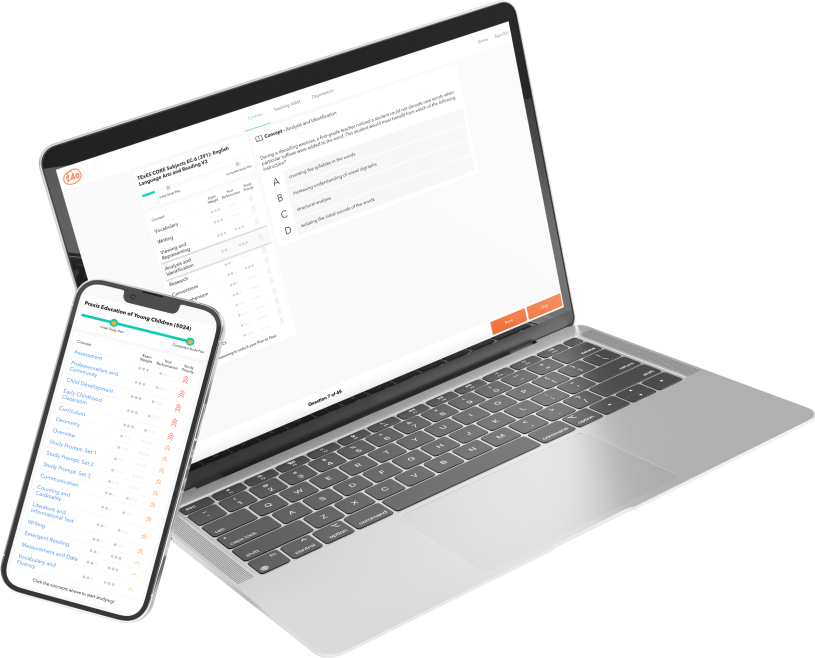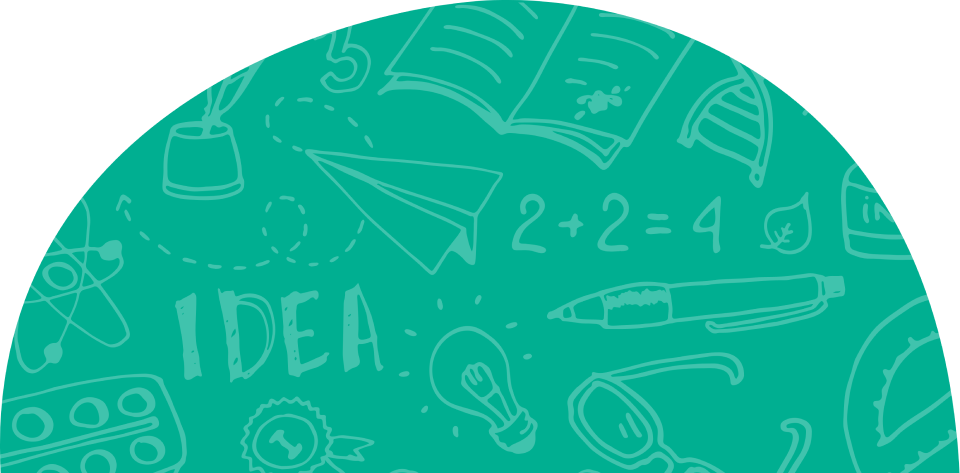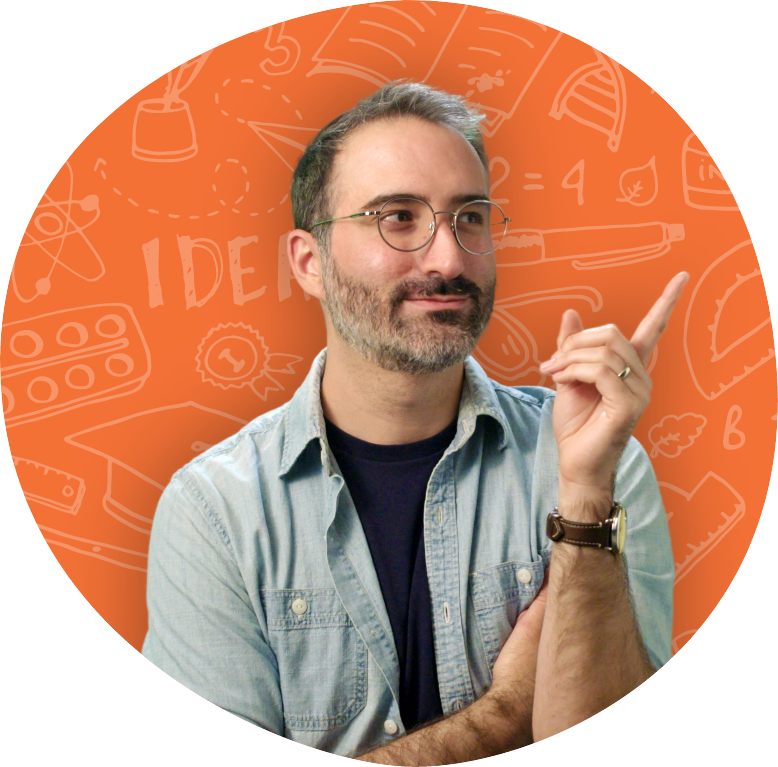Preparing to take the CSET Social Science exam?
Good!
You’ve found the right page. We will answer every question you have and tell you exactly what you need to study to pass the CSET Social Science exam.
Quick Links to Help You Navigate This Page
Quick Facts
Overview
CSET Social Science is a required exam for any California educators who plan to teach a social science at the secondary level.
There are 3 subtests:
- World History and World Geography
- S. History and U.S. Geography
- Civics, Economics, and California History
You can register to take any one subtest or all three subtests in a single test session.
The exam is a computer-based test, but don’t worry, you just need basic computer skills. If you made it to this point in your education and career, you have nothing to worry about.
Here is the subtest format:
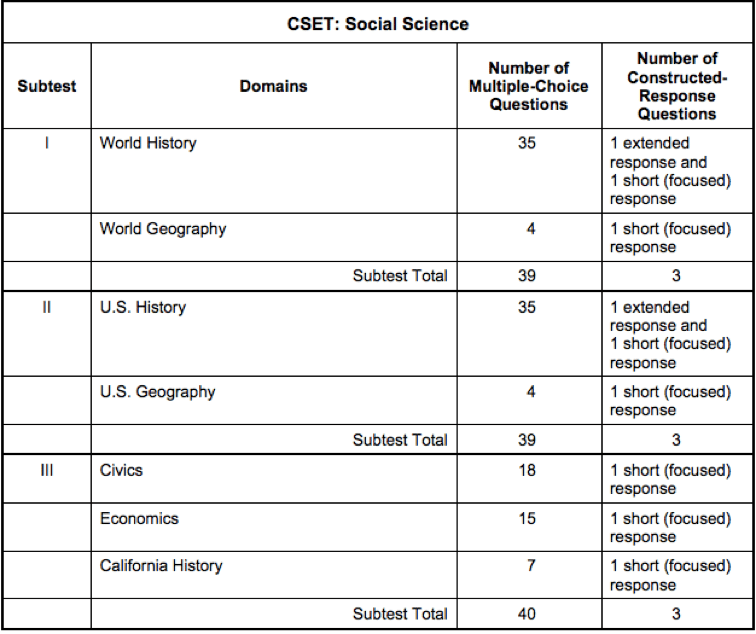
If you take all three subtests at once, you will have six hours and fifteen minutes to complete the entire exam. You will be presented with one subtest at a time. Subtests are individually timed and are administered in consecutive order.
If you do not take all three subtests at once, the time allotment is as follows:
- Subtest I: 2 hours and 15 minutes
- Subtest II: 2 hours and 15 minutes
- Subtest II: 1 hour and 45 minutes
Cost: $99 per subtest
$297 for all subtests taken together
Dates and Locations: Tests are by appointment only, year-round. Click here to find a testing site near you.
What to Bring: You must bring one piece of current, government-issued identification printed in English, in the name in which you registered, bearing your photograph and signature. Click here for more info.
Number of Attempts: There are no limits on how many times you can take the test before you pass; however, you do have to wait 45 days between testing attempts.
Scoring: You need to score at least 220 points per subtest. All three subtests must be passed. You can expect your official score within seven weeks.
For CSET policies and rules, click here.
Register for the CSET Social Science exam here.
Frequently Asked Questions
How long will the CSET Social Science exam take me?
If you take all three subtests in a single session, you will have 6 hours and 15 minutes to complete the exam but expect to be at the testing site longer. It takes time to get checked in and get started. Plan to arrive at least 15 minutes before your appointment time.
If you do not take all three subtests at once, the time allotment is as follows:
- Subtest I: 2 hours and 15 minutes
- Subtest II: 2 hours and 15 minutes
- Subtest III: 1 hour and 45 minutes
What can I expect when I arrive at the testing site to take the CSET Social Science exam?
When you get there, expect to have your identification checked, your photo taken, your palm scanned, and to give your digital signature. You will also be asked to place your belongings in secure storage.
Do I get a break during the CSET Social Science exam?
Any time taken for breaks is considered part of your available testing time.
What is a constructed response question?
In most states, constructed response questions (CRQ) are part of educational testing for teachers. These kinds of questions require the test-taker to produce or construct the answer and are considered an additional measure to better assess test-takers subject knowledge. CRQ can be as simple as the writing of a sentence or as complex at the design of a lesson plan.
Click here to learn more about constructed response questions and how to prepare for them.
How do I pass the CSET Social Science exam?
To pass the CSET Social Science test, you must first understand what is on the exam and what you will be expected to know. The best way is to review the 240Tutoring test breakdown materials and practice questions. Once you identify areas of weakness, you can begin targeting those areas with instructional content and practice questions.
How is the CSET Social Science exam scored?
You must score at least 220 points on each subtest to pass the exam. Click here for more information on scoring.
Is the CSET Social Science exam hard?
Yea, it’s challenging. The cumulative passing rate for the CSET Social Science exam is about 80%.
*Source: Annual Report on Passing Rates of Commission-Approved Examinations from 2010-2011 to 2014-2015.
You have to study quality, trusted sources (like 240Tutoring).
World History and World Geography
Overview
You will have 135 minutes to complete 39 multiple-choice questions and 3 constructed-response questions.
Subtest I has two parts: World History and World Geography. They can be further broken down into these big (really big) time periods and concepts:
- World History
- Ancient Civilizations
- Medieval and Early Modern Times
- Modern World History
- World Geography
- Tools and Perspectives
- Diversity and Human Societies
- Culture and the Physical Environment
Ready? Let’s dive into World History.
World History
This section tests your knowledge on important world events, people, and ideas from the past.
Let’s talk about what you need to know about each time period in World history.
Ancient Civilizations
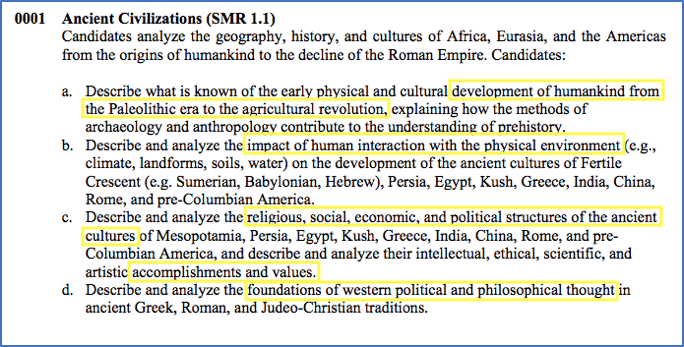
First, you have to know how humankind evolved, both physically and culturally, from the Paleolithic era (Stone Age) to the agricultural revolution. Remember, the agricultural revolution occurred from about 10,000 B.C. to 2,000 B.C. It describes the transition from hunting and gathering to farming.
Also, be able to critically think about how early humans interacted with the environment and how those interactions impacted the development of several ancient civilizations like the Fertile Crescent, Persia, Egypt, Kush, Greece, India, China, Rome, and pre-Columbian America.
For each major ancient civilization, you need to know its religious, social, economic, and political structure and its major accomplishments and contributions. You also need to be able to identify some modern western thinking that originated from those specific ancient civilizations.
Finally, take time to research ancient Chinese and Indian traditions, like Taoism and Hinduism, that form the foundation for Asian political and philosophical structures.
Those are some really (really) broad concepts to think about and study.
Medieval and Early Modern Times
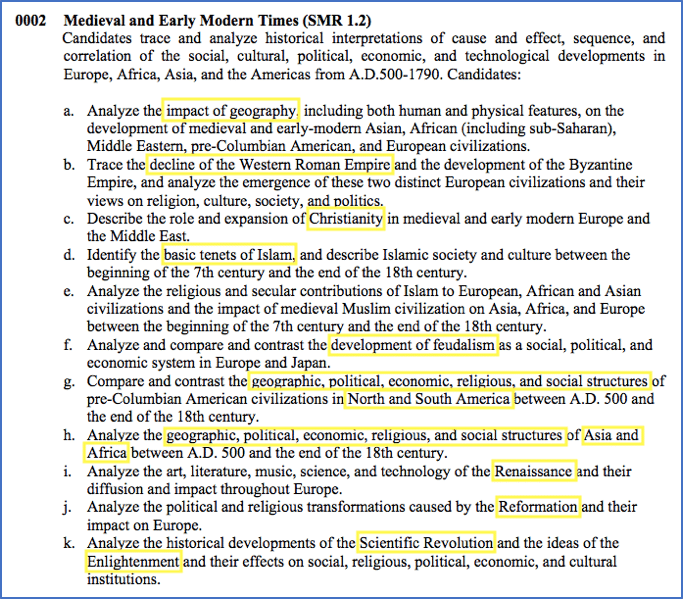
For these questions, you need to know the impact of geography on the development of medieval and early-modern civilizations. Think about water. Most major cities founded during these times are by a river or water source. This is because humans need freshwater and water was the fastest and easiest form of transportation until the invention of the steam engine and railroads.
Be sure to know the major events that led to the fall of the Western Roman Empire and the rise of the Byzantine Empire. Investigate these two civilization’s views on religion, culture, society, and politics.
Think about the religions of Christianity and Islam. Be able to describe the expansion of Christianity during this time and the basic tenets of Islam.
Know what feudalism is and how it developed in Europe and Japan.
You also need to know about the geographic, political, economic, religious, and social structures of North and South America, Asia, and Africa between A.D. 500 and the end of the 18thcentury.
Finally, be really familiar with the Renaissance, the Reformation, the Scientific Revolution, and the Enlightenment.
Whew.
Modern World History
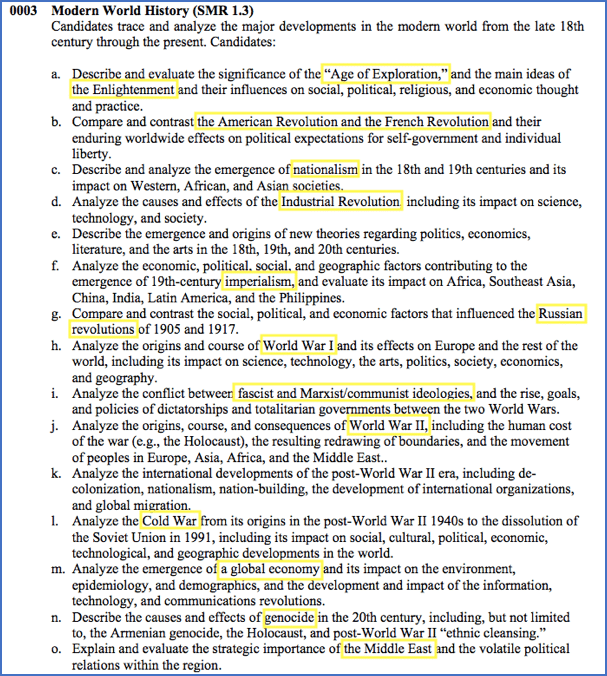
For these questions, you need to know about these events, time periods, and/or ideologies and their lasting impacts on the world:
- Age of Exploration
- The Enlightenment
- American Revolution
- French Revolution
- Nationalism
- Industrial Revolution
- Imperialism
- Russian revolutions of 1905 and 1917
- World War I
- Fascism
- Communism
- World War II
- Cold War
- Globalization
- Genocide (the Holocaust, Armenian genocide)
- Conflict in the Middle East
Important note! The critical thing to know about these events, time periods, and ideologies is their lasting impact on society, politics, culture, the economy, etc. Just knowing what these are and when they happened is not enough. Think super deep!
Specific Concepts for World History
Right now, I’m going to give you five specific concepts to be familiar with because they will most likely appear on the test.
Notable Contributions of Ancient Egypt
The most notable contributions from Ancient Egypt are their advancements in mathematics, written language (hieroglyphics), and agricultural and military technology.
Their most famous achievement is the creation of the Great Pyramids. The pyramids epitomize Egyptian cultural advancements because they are geometrically perfect, the labor force was sustained through agricultural advancements that allowed large amounts of land to be cultivated with less labor, and they were not under threat of attack.
Islam
In A.D. 622, Muhammad was born in the city of Mecca. He prophetically founded a new religion, Islam, meaning “submission to the will of God.” Muhammad and his followers were positioned to spread the new religion because they were travelers and a people of trade.
Eventually a religious army of followers spread the faith through the Middle East and to North Africa and into Spain. Towards the east, Islam spread to India, Malaysia, and Indonesia. The teachings of Islam are studied in the Koran.
Check out this resource on the Five Pillars of Islam.
The Renaissance
The Renaissance, which means “rebirth”, was a philosophical and artistic movement that began in northern Italy. It was an era of renewed interest in the ancient civilizations of Greece and Rome.
The Crusades led to an opening of trade routes with the Arabic nations; the Arabic nations had preserved manuscripts of the ancient cultures and shared these documents with traders. The wealth gained in trading brought power to the merchant class, and a few Italian families grew rich as bankers. They became patrons of the arts and saw art as a social status icon.
The renewed interest in science and scientific truths led to the founding of universities for further academic study. The increase of scientific experimentation and the discovery of laws governing the natural world reduced belief in the church; “mystical events” could now be explained through science.
The American Revolution
The American Revolution of 1776 was an uprising of the colonies in America and greatly influenced by the philosophy of John Locke. The grievances of the colonists centered around being taxed without have legal representation in Parliament. The taxes imposed on the colonists resulted from the French and Indian Wars. The cost of the wars was very high, and the English wished to pay the expenses by taxing the colonists.
Additionally, the crown forbade the colonies from migrating to the land west of the Appalachian Mountains and into the Ohio Valley. The colonists wanted to trade with other countries in order to get a better price for their goods but were barred from trading with other countries because the idea of mercantilism viewed colonists as being created for the benefit of the parent countries and trading with other nations was harmful to the parent nations.
The French Revolution
The French Revolution of 1789 was to some degree inspired by the American war for independence. In the French government, the king was absolute. He had unlimited powers over all of his countrymen. The class system was divided into three groups called estates. The first estate was the rich nobility who paid no taxes, as did the second estate. The third estate made up 97 percent of the population and paid the taxes.
After the taxes, there was little income left for citizens in the third estate to purchase basic necessities. The French middle class, the bourgeoisie, led the fight for the ideas of the philosophers Rousseau, Voltaire, and Montesquieu. They called for a separation of powers, just like the colonists in the United States.
The fight began with the storming of the Bastille and ended with the ascension of Napoleon to power. The significance of the war was the establishment of democratic ideals- liberty, equality, and fraternity- throughout the continent of Europe.
You need to be able to compare and contrast the American Revolution and the French Revolution and identify their lasting impacts on the world.
That’s it for World History. Are you overwhelmed? Is it becoming clear that a thorough study guide is exactly what you need to succeed?
Let’s move on to World Geography.
World Geography

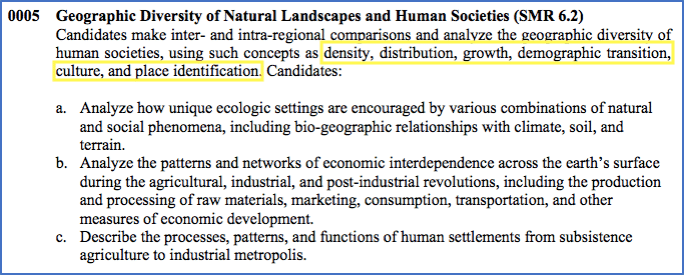


This section will include questions about the physical features of the world and its people.
You need to know how to read and use maps and map projections because you will definitely see both on the test. Be sure you know how to locate important places and regions and explain their importance.
You also need to be able to describe and explain the diversity of different locations and the people who live in each. Be familiar with terms like:
- climate
- terrain
- density
- distribution
- growth
- demographic transition
- culture
- place identification
Finally, think about the relationships between people and the physical environment. More specifically, think about the past relationships (settlement patterns) and current and future relationships that shape environmental policies.
These competencies are very broad. My best advice to you is to find a great study guide to lead you through potential content you may see on the test.
Specific Concepts for World Geography
Right now, I’m going to give you three specific concepts to be familiar with because they could appear on the test.
World Climates
Climate is the average weather for a given place or location. Temperature and precipitation are the two defining characteristics of climate. These, in turn, are determined by various factors, including elevation, mountain barriers, land and water distribution, and latitude. The Earth has ten distinct climates:
- Tropical rainforest
- Savannah
- Desert
- Mediterranean
- Humid subtropical
- Marine
- Humid continental
- Steppe
- Taiga
- Tundra
You need to know what each of these climates are and their characteristics.
Patterns of Settlements
Cities developed based upon site and situation. Site is the physical setting, and situation is how it relates to factors such as available building resources, water supply, food supply, roads, and available natural resources for consumption.
For example, New York was an ideal site for settlement because of the excellent natural harbor. It was the age of sea trade and a safe harbor was essential for growth.
The hot and dry climate of the Australian interior led to the settlement of the coastal area where temperature, humidity, and water supply was more promising. Today, about 90 percent of the population lives in urban areas on or very near the coast in cities such as Sydney, Melbourne, Brisbane, Perth, and Adelaide.
Human-Environment Interaction
Geographers are particularly interested in the interaction between humans and their environment, specifically the way environment impacts the development of culture, and how human activity shapes the environment.
Human interaction with the environment resulted originally from efforts to obtain basic human wants: food, shelter, and clothing. Over time, as wants have become more complex, humans have exerted increasing control over the environment, attempting to shape it to their desires.
And that’s some basic info about the World History and World Geography subtest.
U.S History and U.S. Geography
Overview
You will have 135 minutes to complete 39 multiple-choice questions and 3 constructed-response questions.
Subtest II has two parts: U.S. History and U.S. Geography. They can be further broken down into these big time periods and concepts:
- U.S. History
- Pre-Revolutionary Era and the War for Independence
- The Development of the Constitution and the Early Republic
- The Emergence of a New Nation
- Civil War and Reconstruction
- The “Gilded Age”
- The U.S. as a World Power
- The 1920s
- The Great Depression and the New Deal
- World War II
- Post-World War II America
- Post-World War II U.S. Foreign Policy
- Civil Rights Movement
- U.S. Geography
- Tools and Perspectives
- Diversity and Human Societies
- Culture and the Physical Environment
So, let’s start with U.S. History.
U.S. History
This section tests your knowledge on important American events, people, and ideas from the past.
Let’s talk about what you need to know about each time period in United States history.
Pre-Revolutionary Era and the War for Independence
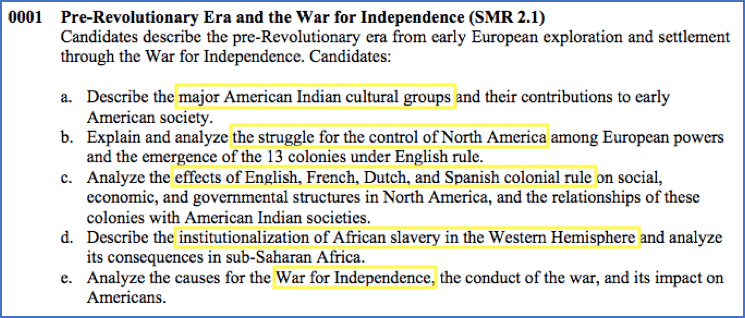
This time period extends from early European exploration to the War for Independence (also known as the American Revolutionary War).
You need to know the early American Indian groups and how they contributed to American society.
Think about the European struggle for control of North America, the beginning of the 13 colonies, and European rule over those colonies.
You also need to know about the introduction of African slavery to the U.S.
Finally, research the American Revolutionary War. Be aware of the causes, major battles, major players, and the impact of the war on the American people.
The Development of the Constitution and the Early Republic

This time period centers around the writing, ratification, and implementation of the Constitution.
You need to know about the political system of the U.S. and the effects of the Enlightenment on the writing of these important documents:
- The Declaration of Independence
- Articles of Confederation
- The Federalist Papers
- The Constitution
- The Bill of Rights
Also, know about the problems regarding the ratification of the Constitution, mostly centering around the Federalist and Anti-Federalists.
The Emergence of a New Nation
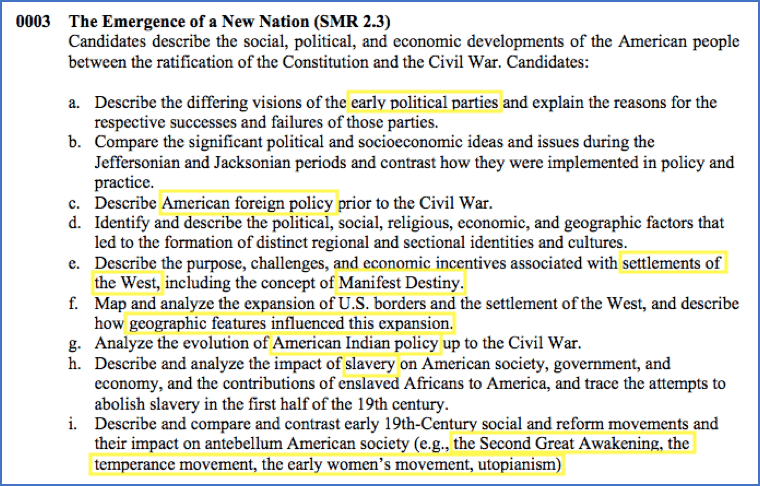
This time period extends from the ratification of the Constitution (1788) to the beginning of the Civil War (1861).
You need to know the different early political parties and their major successes and failures and early foreign policy.
Also, think about the settlement of the West, like Manifest Destiny, the geographic features that influenced this settlement, and U.S. attitudes towards American Indians.
Finally, read about slavery during this time and these specific movements:
- The Second Great Awakening
- The temperance movement
- The early women’s movement
- Utopianism
Civil War and Reconstruction

This time period extends from the Civil War (1861) through the Reconstruction Era (1863-1877).
The main things you need to know about this time period are the causes of the Civil War, the strengths and weaknesses of the Union and the Confederacy, the major events and turning points of the Civil War, and the various impacts of the war.
Finally, read about the Reconstruction Era, specifically about issues regarding race like segregation laws, the growth of white supremacist groups, and the 13th, 14th, and 15thamendments.
The “Gilded Age”
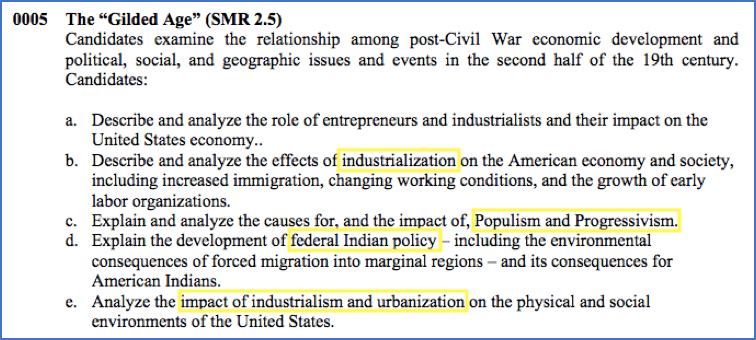
This time period extends from the 1870s to about 1900. Mark Twain dubbed this time period the “Gilded Age” because things looked really good on the surface but were actually pretty bad in reality.
You need to know about industrialization during this time period and the ideas of Populism and Progressivism.
Finally, read about the federal Indian policy and the impact of industrialization and urbanization on the U.S. environments.
The U.S. as a World Power

This time period centers around the early 20thcentury.
For this time period, you have to know about the American imperialistic policies surrounding the Spanish-American War.
Also, know the significance of these:
- the Panama Canal
- the “Open Door” policy with China
- “Big Stick” Diplomacy
- “Dollar” Diplomacy
- Moral Diplomacy
Finally, you need to know about the consequences and impact of World War I on America.
The 1920s
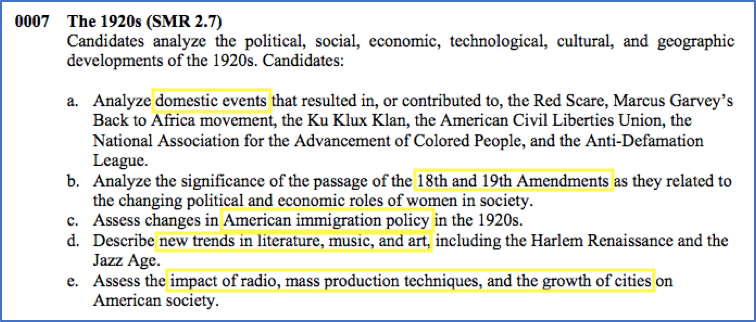
This time period covers, bet you can’t guess, the 1920s!
For this jazzy period, you need to know about these specific happenings and groups:
- the Red Scare
- Back to Africa movement
- the Ku Klux Klan
- the American Civil Liberties Union
- the National Association for the Advancement of Colored People (NAACP)
- the Anti-Defamation League
- the passing of the 18thand 19thAmendments
- the changes in immigration policy
Finally, read about the new trends of the arts, the spread of radio, and the growth of American cities.
The Great Depression and the New Deal
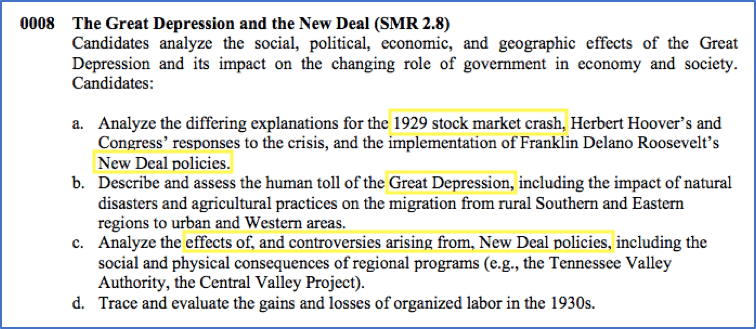
This time period covers 1929 to 1939.
You have to know about the 1929 stock market crash, the New Deal policies, and the effects/controversies of the New Deal policies.
Make sure you read about the impact of the Great Depression, including the physical impact caused by natural disasters and agricultural methods.
World War II

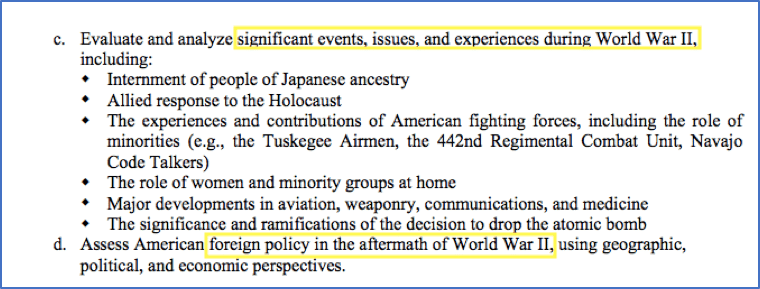
This time period spans from 1939-1945.
You need to think about America’s involvement in World War II, including the changes of foreign policy before, during, after the war.
Also, make sure you know these events and issues that will more than likely show up on the test:
- internment of people of Japanese ancestry
- the Holocaust
- the role of minorities in the war
- the role of women at home
- major developments in technology
- the atomic bomb
Post-World War II America
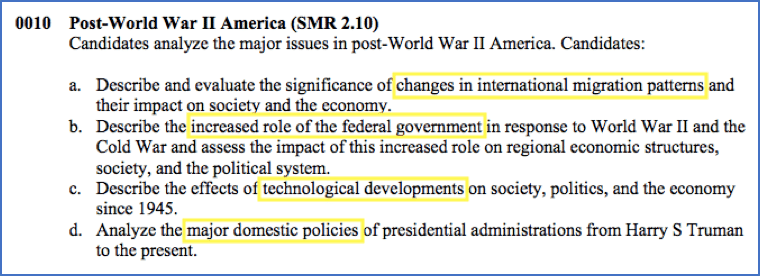
This period focuses on the time right after World War II.
For this time period, you need to know about the change of immigration patterns, the increased presence of the federal government, new technology developments of the time, and the major domestic policies.
Post-World War II U.S. Foreign Policy
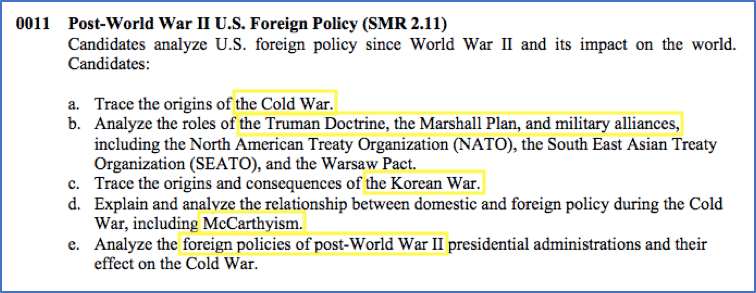
This time period focuses on foreign policy beginning after World War II up to the present.
For this section, you need to know all about:
- the Cold War
- the Truman Doctrine
- the Marshall Plan
- the North American Treaty Organization (NATO)
- the South East Asian Treaty (SEATO)
- the Warsaw Pact
- the Korean War
- McCarthyism
- the Vietnam War
Civil Rights Movement

And, finally, the last time period covers from about 1954-1968.
For this section, you need to know about the important people, events, policies, and court cases regarding civil rights and the impact of each on America.
Finally, read about the women’s rights movement.
Whew, that’s a lot of time periods, events, people, and issues to know about. You could do an internet search for each of these broad topics (and hope you find quality, accurate resources). Or, you can find a trusted study guide to use (I know a great one!).
Specific Concepts for U.S. History
Right now, I’m going to give you five specific concepts to be familiar with because they will most likely appear on the test.
Articles of Confederation
The Articles of Confederation was the first governing document for the United States of America. These Articles created a weak federal government that really couldn’t respond to the demands of the new nation. The Articles of Confederation was replaced by the U.S Constitution of 1787.
13th, 14th, and 15th Amendments
These three amendments were ratified after the Civil War and eliminate slavery in the U.S. and secure voting rights for any race ethnicity. More specifically:
The 13thamendment abolished slavery.
The 14thamendment ensured citizenship rights and protections to all former slaves.
The 15thamendment gave African American men the right to vote.
Spanish-American War
After the end of the Indian Wars in the 1870s and the settlement of the Great Plains by thousands of immigrants in the 1880s, Americans had nowhere else to expand on the North American continent. However, the need for new markets and new space continued, leading into an era of American imperialism, as Americans set their sights on overseas.
Meanwhile, by 1897, the Cuban effort for independence was in full swing and Americans were sympathetic to their cause, as well as interested in increasing their political and economic influence in the Caribbean. On February 15, 1897, the USS Maine sank in the port of Havana and America blamed the Spanish. This was the last straw for American sentiments and the United States declared war on Spain.
The war was fought in the Atlantic and the Pacific. It only lasted four months and the United States was the clear victor in the conflict. In the Treaty of Paris (1898) the United States gained Spain’s colonies in the Philippines, Guam, and Puerto Rico; and Cuba gained its independence in the treaty, although the US added a provision, the Platt Amendment, allowing for American oversight of their political decisions.
Politically, the war established the United States as a world power and effectively ended the Spanish Empire. The war solidified the United States as a naval power and led to the rise of Theodore Roosevelt as an American icon.
McCarthyism
Put very simply, the term McCarthyism is used when innocent people are victimized using significant but unproven accusations. The term comes from the 1950s when U.S. Senator Joseph McCarthy accused many people in the U.S. federal government of communism and treason.
Civil Rights Movement
The Civil Rights Movement was a mass popular movement to secure equal rights for African-Americans who faced racism and segregation.
Some notable events to research and know are:
- Montgomery Bus Boycott (1955-1957)
- Little Rock 9 (1957)
- March on Washington (1963)
Selma to Montgomery March (1965)
U.S. Geography
This section will include questions about the physical features of the U.S. and its people.
These competencies look very similar to the World Geography competencies. In fact, they are the exact same. So, let’s just apply this knowledge to some specific concepts for U.S. Geography.


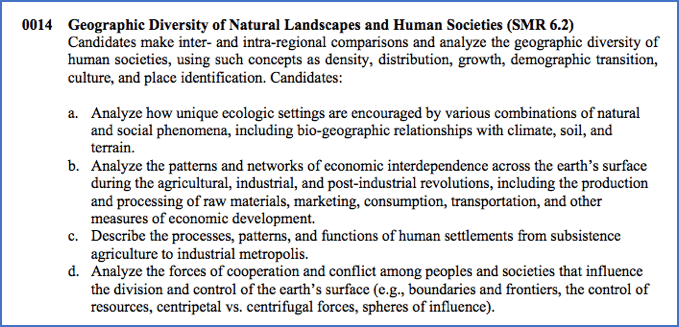

Specific Concepts for U.S. Geography
These are very likely to appear on the test.
Physical Regions of U.S.
You need to know the 4 different physical regions of the U.S. Within each region, there are various divisions:
- Northeast
- New England
- Mid-Atlantic
- Midwest
- East North Central
- West North Central
- South
- South Atlantic
- East South Central
- West South Central
- West
- Mountain
- Pacific
Make sure you know which states fall into each region.
Important Physical Features of North America
The following are important physical features that spread throughout North America, including the U.S.:
Appalachian Mountains: A mountain range running vertically in Eastern North America. The range forms a barrier inhibiting east-west travel along the entire length of the eastern side of the continent. The Appalachians contain large deposits of coal, leading to a booming coal industry that can have serious environmental consequences.
Mississippi River: Starting in Minnesota, the Mississippi River runs slowly down to the Gulf of Mexico. The waterways of 31 states and 2 Canadian provinces drain into the Mississippi. The Mississippi River has served as host to several significant populations and civilizations, a barrier to travel, and as a significant avenue for trade. In the 1700 and 1800s, the world’s powers all vied to control the river because by doing so, they controlled the continent’s trade.
Rocky Mountains: Stretching over 3,000 miles from British Columbia in Canada to New Mexico, the Rockies are the tallest mountain chain in North America. The Continental Divide is located in the Rockies. All water to the west of the divide flows to the Pacific, while all water to the east flows to the Atlantic.
Thematic Maps
You may be asked to look at state-by-state thematic maps to compare or contrast regions within the U.S. A thematic map depicts a particular special topic in an area. For example, an electoral map is a thematic map.
And that’s some basic info about the U.S. History and U.S. Geography subtest.
Civics, Economics, and California History
Overview
You will have 105 minutes to complete 40 multiple-choice questions and 3 constructed-response questions.
Subtest III has three parts: Civics, Economics, and California History. They can be further broken down into these concepts or time periods:
- Civics
- Principles of American Democracy
- Fundamental Values and Principles of Civil Society
- The Three Branches of Government
- Landmark U.S. Supreme Court Cases
- Issues Regarding Campaigns for National, State, and Local Elective Offices
- Powers and Procedures of the National, State, Local and Tribal Governments
- The Media in American Political Life
- Political Systems
- Tensions within our Constitutional Democracy
- Economics
- Economic Terms and Concepts and Economic Reasoning
- Elements of America’s Market Economy in a Global Setting
- The Relationship between Politics and Economics
- Elements of the U.S. Labor Market in a Global Setting
- Aggregate Economic Behavior of the American Economy
- International Trade and the American Economy
- California History
- Pre-Columbian Period Through the End of Mexican Rule
- From the Gold Rush to the Present
So, let’s start with Civics.
Civics
This section tests your knowledge on the rights and duties of citizenship.
Let’s talk about what you need to know for each civics competency.
Principles of American Democracy
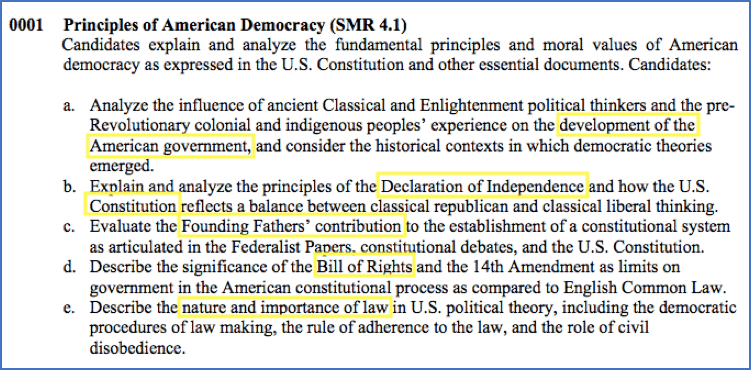

For this concept, you need to know what influenced and shaped the development of the American government. Think about important American documents like the Declaration of Independence, the Constitution, and the Bill of Rights. Be able to compare the Bill of Rights to English Common Law.
Know the Founding Fathers’ contributions to America and the principles of democracy:
- autonomy/liberty
- equality
- basic opportunity
- debate and deliberation
- representation
You have to understand the process of American law and the responsibilities of citizenship.
Finally, know what it takes to become an American citizen. Check out this resource for more info.
Fundamental Values and Principles of Civil Society
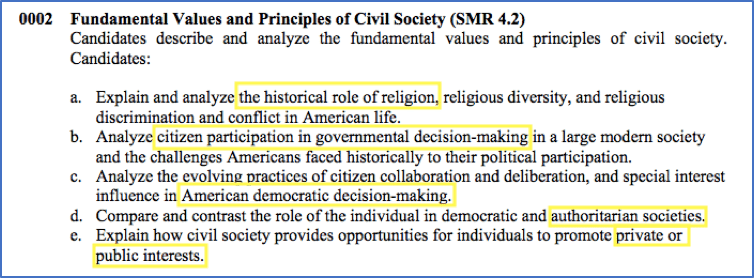
The first thing you need to know is about religion in America. Think about the historical role of religion and how people have been and currently are discriminated against for their religious beliefs.
The next big thing you need to know about is decision-making. More specifically, think about American citizens’ roles in the government. How do they participate and express their interests? Be able to compare their roles with roles of those living under authoritarian rule.
The Three Branches of Government

Make sure you know the three branches of government (executive, legislative, and judicial) and Articles I, II, and III.
Finally, you need to know why the checks and balances system isn’t always perfect and how the Constitution can be amended.
Landmark U.S. Supreme Court Cases
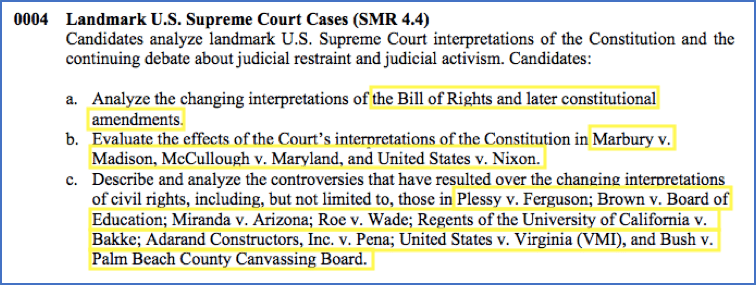
There have been a lot of really important, life-changing court cases. These decisions were the result of the Supreme Court’s interpretation of the Constitution. Make sure you read the Bill of Rights, new amendments, and a thorough summary of each of these court cases:
- Marbury v. Madison
- McCullough v. Maryland
- United States v. Nixon
- Plessy v. Ferguson
- Brown v. Board of Education
- Miranda v. Arizona
- Roe v. Wade
- Regents of the University of California v. Bakke
- Adarand Constructors, Inc. v. Pena
- United States v. Virginia (VMI)
- Bush v. Palm Beach County Canvassing Board
Think about the controversies surrounding these cases, especially about the changing interpretations of civil rights.
Issues Regarding Campaigns for National, State, and Local Elective Offices

This competency is all about politics. I know what you’re thinking. Great, politics. But I promise you it isn’t that bad.
You need to know the different political parties, both those of the past and present and how the basic political process works, including the electoral college.
Finally, be sure to know the terms state redistrictingand reapportionmentand the issues that surround them.
Powers and Procedures of the National, State, Local and Tribal Governments

For this section, you will have to answer questions about the government, at all levels. Know how the federal, state, local, and tribal governments are organized and what jurisdiction they have over certain issues. Also, think about the power and influence held by government officials.
The Media in American Political Life

You will more than likely see a question on the test about the role of media in the American political process. Make sure you know why a free press is important, the media’s role in America, and how government officials use the media to communicate.
Political Systems

You will more than likely see a question on the test about the role of media in the American political process. Make sure you know why a free press is important, the media’s role in America, and how government officials use the media to communicate.
Political Systems

This is another competency about politics. For this one, you need to know about the different political systems, like the parliamentary system, and the problems that new democracies have faced.
Tensions within our Constitutional Democracy

And finally, the last big concept for Civics. You may be asked about two tensions within American democracy: separation of church and state and a majority-rules system. Read about each of these and why they are considered tension-creators.
Wow, that was a lot of broad (kind of vague) info about Civics.
Specific Concepts for Civics
Right now, I’m going to give you five specific concepts to be familiar with because they will most likely appear on the test.
Common Law
These are laws created and developed through judicial decision, typically by courts (case law). Common law is derived from tradition and previous responses to situations. Common law originated in England.
The Constitution
The Constitution is divided into seven articles:
- Article 1- The Powers, Eligibility Requirements and Limitations of the Legislative Branch
- Article 2- The Powers, Eligibility Requirements and Limitations of the Executive Branch
- Article 3- The Powers, Eligibility Requirements and Limitations of the Judicial Branch
- Article 4- The roles, rights, and privileges of the States and Their Citizens
- Article 5- The Amendment Process
- Article 6- Maintenance of Previous Debts, Supremacy of the Constitution, and Oaths of Office
- Article 7- The Ratification Process
The structure of the US government is based, primarily, on the first three articles.
How Laws Are Made
A law is made when a bill is passed by Congress. This process, at a basic level, looks like this:
- A Congressional member creates a bill and presents it to a particular committee (each bill must be presented to the committee which deals with those matters). For example, a bill about highway improvements would be sent to the Transportation Committee.
- The chairperson decides whether or not to hear the bill. If the chairperson decides to hear the bill, it is brought before the committee.
- The committee hears testimony and debate on the bill, adds any amendments they wish, and then votes on the bill.
- If the bill passes out of committee, it is brought before the house it originates in, whether the Senate or House of Representatives. The house votes on it. If it passes with a simple majority, then the bill moves to the next house of Congress.
- Then the next house of Congress votes on the bill. If a majority of the members vote yes- it goes to the President who can either veto it- sending it back to Congress- or sign it into law.
- If a bill is vetoed, 2/3 of Congress can vote in favor of the bill and make it law.
United States v. Nixon (1974)
This case ruled that the President did not have “an absolute, unqualified, Presidential privilege of immunity from the judicial process under all circumstances.”
The case was in response to President Nixon’s attempt to withhold key evidence in the Watergate scandal; the tapes had incriminating evidence that President Nixon had participated in illegal activities. 15 days after the ruling, President Nixon resigned from office.
The case is a landmark case because it is a key exercise of the checks and balances system where the Supreme Court limited the powers of the executive branch.
Amendment Process
There are two ways to amend the Constitution:
- Congress to States- An amendment can be passed if 2/3 of each house of Congress approves an amendment AND 3/4 of the State’s legislatures ratify the amendment.
- Constitutional Convention- If 2/3 of the States call together a Constitutional Convention, the convention can amend the constitution. These amendments take effect when 3/4 of the states ratify the new amendments.
Economics
This section tests your knowledge on how people produce, distribute, trade, and consume goods and services.
Let’s talk about what you need to know for each economics competency.
Economic Terms and Concepts and Economic Reasoning
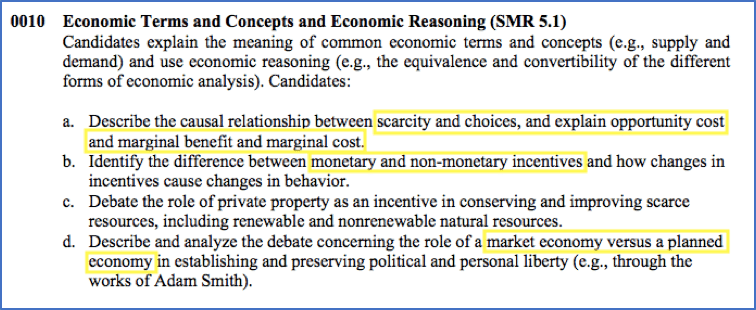
For this first competency, you have to know some basic economic terms like:
- supply and demand
- scarcity and choices
- opportunity cost
- marginal benefit
- marginal cost
Check out this great introduction to economics here.
You also need to know some very basic behavioral economic concepts, like how incentives, both monetary and non-monetary, motivate people.
Finally, make sure you know what a market economy and planned economy are.
Elements of America’s Market Economy in a Global Setting
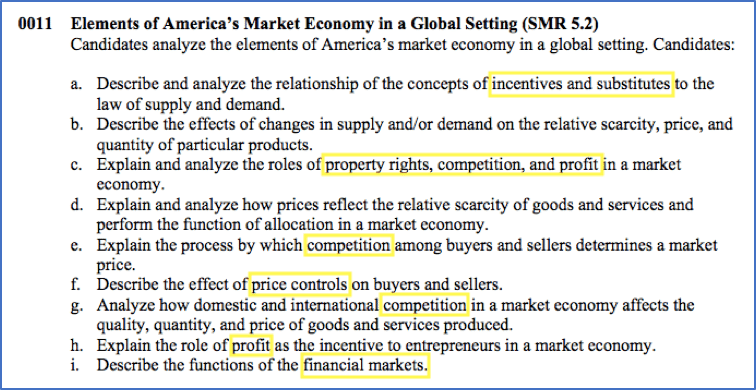
For this section, you really need to understand America’s market economy and its role in the world. This includes knowing about:
- substitutes
- property rights
- competition
- profit
- price controls
- financial markets
The Relationship between Politics and Economics
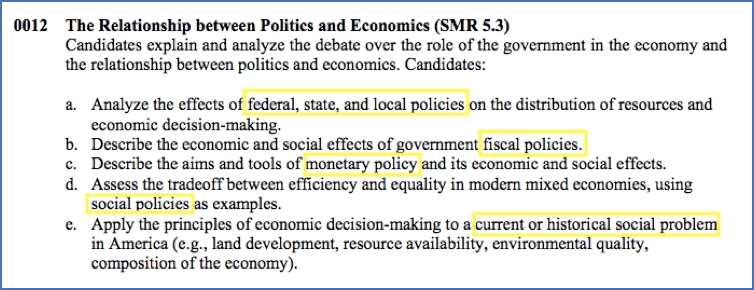
Make sure you know how the government affects the economy through fiscal policy, monetary policy, social policy, and other decision-making. Also, think about how this decision-making relates to specific problems in America.
Elements of the U.S. Labor Market in a Global Setting
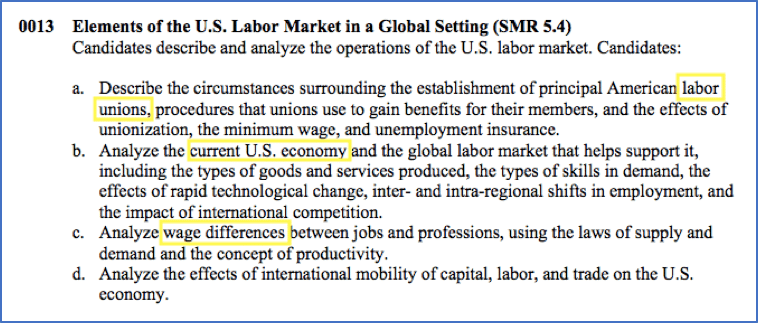
Regarding the labor market, you have to know how unions work and how they benefit their members. Also, think about America’s current situation in terms of skills in demand, wages, technology, competition, etc.
Aggregate Economic Behavior of the American Economy

Think about macroeconomics (big picture) here. Look up and know the ins and outs of these terms:
- indexes
- unemployment
- inflation
- real GDP
- short- and long- term interest rates
International Trade and the American Economy
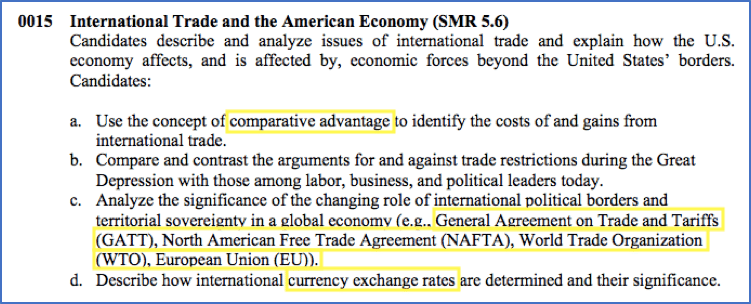
And finally, let’s think about international trade. Be sure and know these terms that relate to trade:
- comparative advantage
- General Agreement on Trade and Tariffs (GATT)
- North American Free Trade Agreement (NAFTA)
- World Trade Organization (WTO)
- European Union (EU)
- currency exchange rates
Specific Concepts for Economics
Right now, I’m going to give you five specific concepts to be familiar with because they will most likely appear on the test.
Scarcity
Scarcity is the basic problem of the gap between our wants/needs and the available resources. No human has all of the resources necessary to fulfill every need and desire. Because of this, people must use cost-benefit analysis to make their choices. This means that they make trade-offs and decisions as to best allocate their resources.
Opportunity of Cost
Because all resources are scarce, all actions have an opportunity cost. An opportunity cost is the benefits you miss out on when you choose one thing over another.
Take a look at this example:
Bob is home alone on Tuesday night. He wants to watch a television program or play a computer game. He decides to play a computer game. The opportunity cost of playing the computer game is not watching television.
Be able to identify the opportunity cost of a choice.
Supply and Demand
In simple terms, supply is how much of something is available and demand is how much of something people want.
There are a lot of factors that affect supply and demand, and its actually pretty complicated. Take some time to read about supply and demand and know these terms:
- Law of demand
- Law of supply
- Economics of scale
- Equilibrium
- Disequilibrium
- Surplus
- Deficit
- Elasticity
Competition
Voluntary exchange and private property, combined with the natural scarcity of resources, creates an environment of competition among market participants. This is the driving force of a capitalist economy.
In theory, firms will strive for a greater share of the market to sell or buy goods or services. In doing so, they must create goods of higher quality and cheaper price to attract customers to consume their products. When firms compete in this manner, the best firms are awarded profits and are able to continue, while weak firms are punished with losses and—if they do not adapt—are driven from the market. The consumer wins when companies compete because they receive a better product, typically at a cheaper price.
Comparative Advantage
This is the ability of an entity to produce a good or service at a lower opportunity cost than another entity.
Check out this resource.
California History
This section tests your knowledge on past Californian events and people.
Let’s talk about what you need to know for the two California history competencies.
Pre-Columbian Period Through the End of Mexican Rule

For this time period, you need to know about California’s American Indians, the impact of Spanish exploration and colonization, and the causes and impact of the Mexican-American War.
From the Gold Rush to the Present
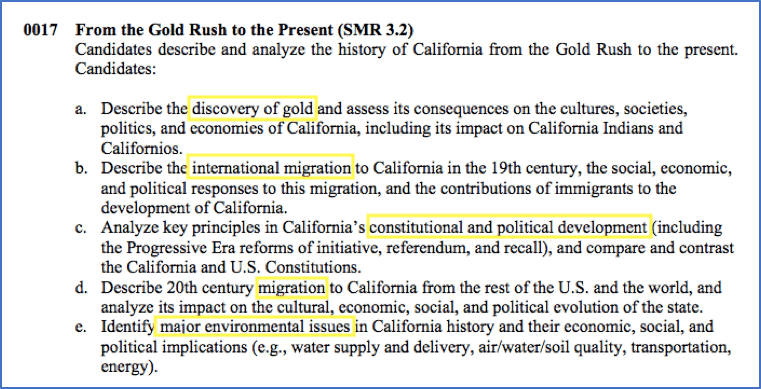
The last bit of Californian history you need to know includes the gold rush, history of immigration, constitutional and political development, and major environmental issues.
Specific Concepts for California History
Right now, I’m going to give you two specific concepts to be familiar with because they could appear on the test.
The Gold Rush
Shortly after the acquisition of the California lands, massive deposits of gold were discovered, leading to a gold rush. Prospectors migrated to the region in hopes of striking rich with gold. Tens of billions of dollars’ worth of gold bullion would be found by miners, but the majority of the miners would not strike it rich, and even some who did gamble and spent their fortune away.
In hindsight, many benefactors of the land rush were not the miners, but service providers such as bartenders, tailors, and shop owners. The largest effect of the gold rush was the instant increase in population in the western lands. Upon reaching California, many settlers chose not to leave but began farming or otherwise settling the area.
The Mexican-American War
In 1845, the United States annexed the Republic of Texas, which ignited a war with Mexico because they felt they still had a right to the Texas lands. The war did not last long as the United States was a stronger military and economic power. The war ended with the signing of the Treaty of Guadalupe Hidalgo in 1848.
This treaty gave the northern Mexican lands to the United States, including modern-day California, Nevada, Utah, and Arizona, in exchange for 18 million dollars. The result of the Mexican-America War was that America finally achieved the expansion from one ocean to another.
And that’s some basic info about the Civics, Economics, and California History subtest.

